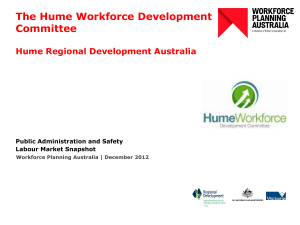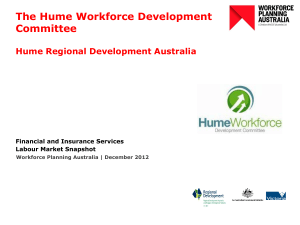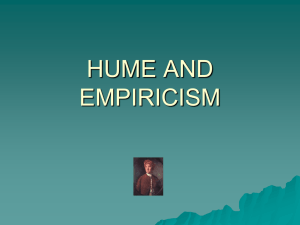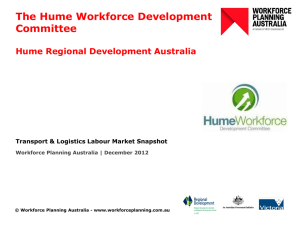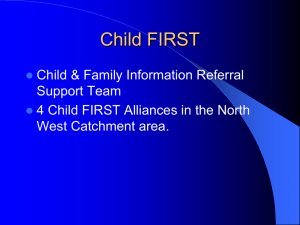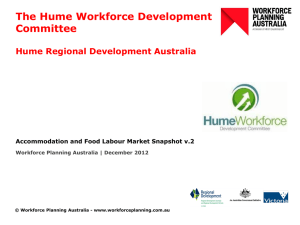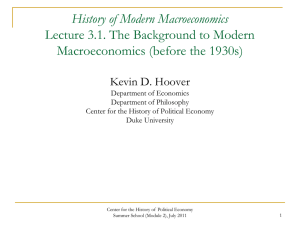Education and Training (PPT ) - Regional Development Victoria
advertisement
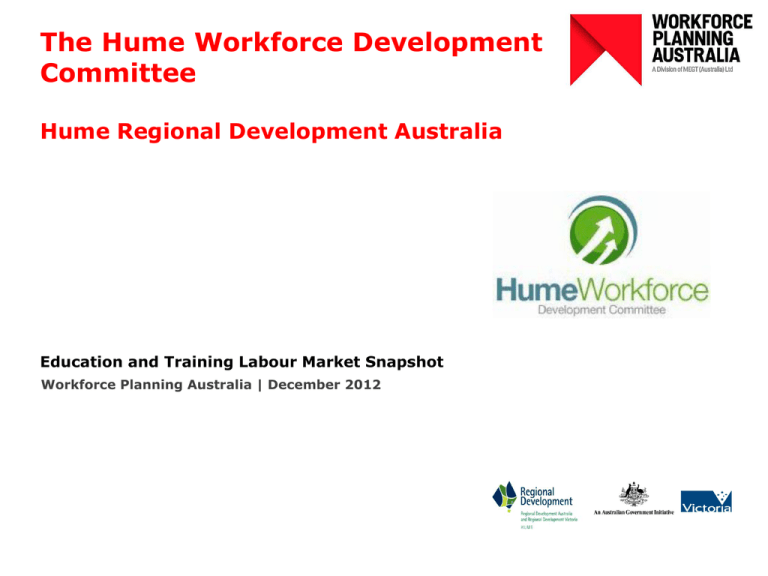
The Hume Workforce Development
Committee
Hume Regional Development Australia
Education and Training Labour Market Snapshot
Workforce Planning Australia | December 2012
Education and Training Industry
The Education and Training Industry includes the following sectors.
Source: DEEWER, Skills Info, 2012
2|
Tertiary
Education
Preschool
Education
School
Education
Adult,
Community
and Other
Education
Education and Training Industry
National Overview
Education and Training is the sixth largest of the 19 industries classified by ANZSIC*.
In August 2012 there were approximately 894,000 persons, or 7.5% of the workforce
employed in this industry.
Nearly 70% of people working in Education and Training are women. The industry has the
second highest proportion of women of all 19 industries. Only ‘Health and Social
Assistance’ has a higher proportion of women.
The median age of workers is 44 years and nearly 50 per cent of the Education and
Training workforce is aged over 45.
Approximately 39% of people in the industry work part time.
There are nearly 5,000 Registered Training Organisations (RTOs) in Australia including
TAFE-institutes, private businesses and enterprise-based RTOs.
Source: DEEWR, Education and Training Employment Outlook, Skills Info 2012, * Australian New Zealand Standard Industrial Classification
3|
Education and Training
Industry Employment
•
Education and Training is the sixth largest employing industry in Australia.
•
At August 2012 there were an estimated 894,000 persons working in this industry
Industry Employment Level February 2012
Source: ABS Labour Force Survey (trend data) cat. No. 6291.0.55.003. - Skills Info, 2012
4|
Education and Training
Projected Employment Level
The past decade has seen steady growth in ‘Education and Training’ employment, although
employment levels have shown some fluctuations from year to year.
Education and Training - Employment Level ('000s)
August 1994 to 2012
1000
894.9
900
821.2
2008
2009
857.8
2010
2011
776.5
800
700
600
817.3
858.5
594.4
601.0
593.5
1995
1996
1997
615.1
634.9
637.7
1999
2000
656.8
713.5
704.0
2003
2004
679.3
736.6
737.2
2005
2006
561.8
500
400
300
200
100
0
1994
1998
2001
2002
Source: ABS Labour Force Survey (trend data) cat. No. 6291.0.55.003. - Skills Info, 2012
5|
2007
2012
Education and Training
Employment level by segment (2007-2012)
•
‘School Education’ is the largest segment in the Education and Training industry
employing nearly 450,000 people. This is more than double the number of people
employed in ‘Tertiary Education’, which is the second largest segment.
Education and Training - Employment Level - Feb 2012 ('000s)
School Education
448.2
Tertiary Education
227.3
Adult, Community and Other Education
139.1
Preschool Education
35.6
Educational Support Services
3.8
0
50
100
150
200
Source: ABS Labour Force Survey (trend data) cat. No. 6291.0.55.003. - Skills Info, 2012
6|
250
300
350
400
450
500
Education and Training
Past Employment Growth (2007-2012)
•
Between 2007 and 2012 the ‘Adult, Community and Other Education’ Sector showed the
strongest employment growth, contributing more than 87,000 jobs.
•
School education experienced negative employment growth for these five years.
Education and Training - Five Year Emp Growth (000s) to Feb 2012
Adult, Community and Other Education
68.7
Tertiary Education
24.9
Preschool Education
5.6
Educational Support Services
2.6
School Education
-7.4
-20
-10
0
10
20
30
40
50
60
70
80
Source: ABS Labour Force Survey (trend data) cat no 6291.0.55.003, DEEWR, Skills Info 2012
7|
Education and Training
Projected Employment Growth by Segment
(2012 – 2016/7)
•
Over the next five years all industry segments are projected to experience some
employment growth
•
In percentage terms the strongest employment growth will be in the ‘Pre-school
Education’ and ‘Adult, Community and other Education’ segments.
Education and Training - Projected Employment Growth
(% pa) to 2016-17
Preschool Education
3.3
Adult, Community and Other Education
2.3
ALL INDUSTRIES
1.4
Education and Training
1.4
Tertiary Education
1.3
School Education
1.0
Educational Support Services
0.5
0.0
0.5
1.0
1.5
2.0
Source: ABS Labour Force Survey (trend data) cat no 6291.0.55.003, DEEWR, Skills Info 2012
8|
2.5
3.0
3.5
Education and Training
Projected Employment growth (‘000)
•
In number terms, the ‘School Education’ and ‘Adult, Community and Other Education”
are projected to experience the strongest employment growth.
•
Employment is projected to increase by 22,000 people in ‘School Education’ and nearly
19,000 in ‘Adult, Community and Other Education’
Education and Training - Future Emp Growth (000s) to 2016-17
School Education
22.5
Adult, Community and Other
Education
16.7
Tertiary Education
15.2
Preschool Education
5.4
Educational Support Services
0.0
0
5
10
15
20
25
Source: ABS Labour Force Survey (trend data) cat no 6291.0.55.003, DEEWR, Australian Jobs, 2011
9|
Education and Training
Top 20 employing occupations
•
Primary School Teachers, Secondary School Teachers and Education Aides are the three
largest occupations working in Education and Training.
Education and Training
- Top 20 Employing Occupations in 2012 ('000s)
Primary School Teachers
148.5
Secondary School Teachers
130.7
Education Aides
69.1
University Lecturers and Tutors
50.6
Private Tutors and Teachers
31.6
Vocational Education Teachers
28.4
General Clerks
24.8
Sports Coaches, Instructors and Officials
19.6
Special Education Teachers
18.6
School Principals
18.2
Early Childhood (Pre-primary School) Teachers
14.2
Child Carers
12.6
Commercial Cleaners
11.8
Receptionists
8.7
Office Managers
8.7
Bookkeepers
7.8
Other Education Managers
7.2
Education Advisers and Reviewers
6.7
Contract, Program and Project Administrators
6.4
Training and Development Professionals
6.3
0
20
40
60
Source: ABS Labour Force Survey (trend data) cat no 6291.0.55.003, DEEWR, Australian Jobs, 2011
10 |
80
100
120
140
160
Education and Training:
Drivers of Workforce Change and
Development
Increased
Year 12
retention
rates
Introduction
of demanddriven
funding
National
Early Years
Learning
Framework
Population
Growth
National
Broadband
Network
(NBN)
Drivers of
Workforce
Change in
Education &
Training
Decreasing
numbers of
international
students
Source: IBSA, Training & Education Environmental Scan 2012, IBISWorld, 2012, DEEWR Employment Outlook, Education and Training, 2011
11 |
Education and Training
Drivers of Workforce Change and
Development
Population Growth
Between 2006 and 2007 the birth rate in Victoria jumped from 67,433 to 72,639. The birth rate has
stabilised at this higher rate of approximately 72,000 births a year. Population growth is having a direct
impact on early childhood and primary school enrolments.
National Early Years Learning Framework
By 2013 the Australian Government’s National Early Years Learning Framework is expected to result in all
children receiving 15 hours a week of education for 40 weeks a year that is delivered by a qualified early
childhood teacher. This is increasing demand for early childhood educators.
More than 50% of pre-school staff will be required to attain or be working towards a diploma level
qualification or higher by 1 January 2014, thereby increasing demand for VET and university educators in
childcare and early childhood education.
Increased Year 12 retention rates (DEEWR)
As part of the Australian Government’s productivity agenda, the government aims to increase Year 12
completion rates to 90% by 2015.
Between 2008 and 2010 Year 12 retention rate in Victoria increased slightly to 81.1%. The increased
retention rate is likely to increase demand for teachers.
NB: In Hume the percentage of early school leavers increased from 14.1% in 2006 to 15.2% in 2010.
Source: Victorian Registry of Births, Deaths and Marriages; IBISWorld, 2012; IBSA, Training and Education Environmental Scan 2012
12 |
Education and Training
Drivers of Workforce Change and
Development
Reform of the VET Sector
The TAFE sector is undergoing change as the federal government embarks on reforming
the vocational training system. Victoria has opened their training systems to market-based
competition and students are now funded through a student entitlement or voucher
system. Student demand now determines government funding.
National Broadband Network (NBN)
The National Broadband Network, technology advances and Australia’s growing digital
literacy is fuelling demand for on-line learning options. This in turn is expected to increase
demand for people with e-learning design skills.
Decreasing International Students numbers
After strong growth in international student enrolments since 2000, Australia suffered a
decline of more than 9% in international student enrolments in 2011. This is one factor
contributing to the slower growth rate projected for the VET, higher Education and
Language sectors over the next five years.
Source: IBSA, Training and Education Environmental Scan, 2012
13 |
Education and Training
Growth Areas
Education and Training Segment
Expected Growth Areas
Early Childhood Sector
Certificate and degree-qualified early childhood educators
Schools Sector
Employment in primary and secondary schools due to
increased enrolments, particularly in Independent schools
Employment in non-teaching, clerical and administrative
roles. These now make up 22.5% of the school workforce
Other Education
Tutoring of school-age children is expected to experience
the strongest growth.
Tutoring of pre-school aged children
Adult and Community Education
Courses that create pathways for disengaged learners, such
as pre-vocational, bridging and foundation skills.
Short courses attractive to baby boomers with increased
leisure time.
Other Education
Courses associated with updating knowledge on changing
regulations, new technology and management practices
Source: IBSA, Training and Education Environmental Scan, 2012, IBISWorld, 2012
14 |
Victorian Overview
Teacher Supply and Demand
Victorian Schools
Profile
•
•
•
Women make up 70% of the workforce in Victoria.
More than 37% of teachers in Government schools are aged over 50.
More than 40% of teachers in Catholic schools are aged over 50.
Demand
•
More than 72,520 teachers are employed in Victorian schools (43,290 in Govt
schools, 15,847 in Catholic schools and 13,384 in Independent schools)
•
Teachers numbers are expected to grow, particularly in Independent schools.
•
Victorian Teacher attrition rates are expected to average around 5% until 2015.
•
Between 2001 and 2011 the proportion of Government school teachers working
part time increased from 17.5% to 23%.
•
In 2011 more than 30% of Catholic teachers worked part time.
Supply
•
•
•
Between 2012 and 2015 an oversupply of primary and secondary teachers is
projected.
However, mathematics, chemistry, physics and language teachers are in demand
and most ‘difficult-to-fill’ vacancies are in rural and regional locations.
An undersupply of early childhood teachers is expected.
Source: DEECD, 2010-2011 Teacher Supply and Demand Report, Oct 2012
16 |
The VET SECTOR - Victoria
Overview
VET Staff work in:
•
TAFE Institutes
•
Dual sector universities
•
Private Registered Training Organisations (RTOs)
•
Secondary Schools
•
Other educational settings
•
The VET sector has a higher proportion of part-time, casual and older workers
compared with the general labour force
The profile of the TAFE Sector is:
•
Total employees 17,360
•
6% of TAFE employees work in the Hume region
•
57% are women and 52% work part time
•
25% are aged over 55
Source: DEECD, 2010-2011 Teacher Supply and Demand Report, Oct 2012, SSA, State of the Sector Report, 2010-2011,(2012)
17 |
Hume Overview
Education & Training Providers in
Hume
Sector
Number of Providers
Early Childhood
Education
104 funded kindergarten programs
• 19 of these are conducted in long day care settings
• 12 multi-service children’s centres are under development
Primary Schools
In August 2010 there were 172 primary schools
• 131 Government
• 29 Catholic
• 12 Independent
Secondary
Schools
23 Government secondary schools
3 P-12 schools
Special
Education
• 5 special schools
Outdoor
Education
• 3 outdoor education and learning centres
Tertiary
Education and
training
Two universities:
• La Trobe University (Wodonga and Shepparton
• University of Melbourne (Dookie and Shepparton)
Two TAFE providers
• GOTAFE
• Wodonga TAFE
36 Learn Local providers
19 |
Source: DEEWR, Regional Education, Skills and Jobs Plan, Victoria– Hume 2012 – 2014, July 2012
Victorian Teacher Supply and
Demand In the Hume Region
Graduate Teacher Employment
Graduate teachers in government schools are often employed near where they trained.
La Trobe University is the largest provider of graduate teachers employed in Hume and
Charles Sturt University the second.
In 2011 the Hume Region employed 130 graduate teachers in government schools.
Difficult-to-Fill vacancies
In 2009-2011, 15 LGAs reported ‘difficult-to-fill’ vacancies in Government schools.
Five of these LGAs were in the Hume region. They were: Mitchell, Strathbogie, Moira,
Wodonga, and Alpine LGAs all reported difficult to fill vacancies.
In 2009-2011 15 LGAs reported difficult-to-fill vacancies for mathematics. Five of these
LGAs were in Hume. They were: Benalla, Wodonga, Moira, Towong and Mitchell.
Source: DEECD, 2010-2011 Teacher Supply and Demand Report, Oct 2012
20 |
Education & Training
Hume Regional Education, Skills and
Jobs (RESJ) Plan 2012 - 2014
The Australian Government’s Hume RESJ Plan has identified 11 Issues. They are as
follows:
1. Closing the Gap for indigenous people.
2. Availability of a suitably qualified workforce in early childhood education and childcare
services within the region.
3. The need for a comprehensive workforce development strategy for the Hume region.
4. The level of engagement by young people with school and skills development,
including vocational education and training.
5. The need to build skills for industries with immediate and future skills requirements.
6. Low levels of literacy impacting on people’s ability to participate in employment,
vocational education and training and higher education.
7. Knowledge of local career, education, employment and training opportunities.
8. Relatively low levels of tertiary attainment and participation across the region.
9. Level of Year 12 (or equivalent) attainment and retention.
10. Level of labour market participation in particular localities.
11. Implementation of the Murray-Darling Basin Plan.
21 |
Source: DEEWR, Regional Education, Skills and Jobs Plan, Victoria– Hume 2012 – 2014, July 2012
The Hume Strategy
Education priorities and progress August
2012
The Hume Strategy for Sustainable Communities 2010-2012 has the following priorities:
Key Direction 5 - Embracing learning for life
Priority Strategies
•
Create 21st Century spaces for communities through growth and sharing of
resources.
•
Provide opportunities for young people to engage with learning through multiple
pathways and seamless transitions.
•
Foster a culture of excellence and aspirations.
Focus for 2010-2012
Lifelong Learning: Collaborative approach to develop a regional education sector strategy
Significant developments between 2010-2012 include:
•
Funding of $2million for integrated children’s centres at Bright, Mansfield and
Wodonga.
•
Establishments of Trade training centres and Science and language centres
•
Implementation of the Wannik Learning Together Journey to our Future for Koori
students.
•
Allocation of $3.3million Regional Partnerships Facilitation Funding for U2Uni.
22 |
Education and Training
Employment by LGA
Total Industry
8,070 (2006)
8,840 (2011)
9.5%
2006 vs. 2011 Census Data
Moira
610 (2006)
662(2011)
G Shepparton
1,876 (2006)
2,077 (2011)
Indigo
576 (2006)
625 (2011)
Murrindindi
537 (2006)
531 (2011)
Source: ABS 2006 Census Data and ABS 2011 Census Data
23 |
Towong
206 (2006)
212 (2011)
Benalla
426 (2006)
455 (2011)
Strathbogie
269 (2006)
284 (2011)
Mitchell
924 (2006)
1,068 (2011)
Wodonga
1,122 (2006)
1,221 (2011)
Wangaratta
856 (2006)
878 (2011)
Mansfield
301 (2006)
417 (2011)
Alpine
367 (2006)
410 (2011)
Hume Region Boundary
Sub-region Boundary
Local Government Area
(LGA) Boundary
OUTDOOR EDUCATION –
OUTDOOR EDUCATION WORKERS
Between 2006 and 2011 the number of people across Australia whose main occupation
was ‘Outdoor Adventure Guide’ increased from 1,204 to 1,909, an increase of 58%.
Between 2006 and 2011 the number of people across Victoria whose main occupation
was ‘Outdoor Adventure Guide’ increased from 279 to 548 an increase of 96%.
In the Hume Region the number of people working as outdoor Adventure Workers as their
main occupation increased from 39 to 118 between 2006 and 2011.
The Hume Region has several Outdoor Education Facilities including:
•
The Alpine School in Dinner Plain (DEECD)
•
Rubicon Outdoor Education near Alexandra (DDECD)
•
Bogong Outdoor Education Centre (Bogong Village and 15 Mile Creek)
•
Mittigundi, Glen Valley
Adventure Guides Australia have activities based at Mt Buffalo.
Skills Hub The Industry Advisory Board in Victoria for the Cultural and Recreation
Services
lists ‘Outdoor Adventure Instructors as both a skill in demand and an occupation facing
‘critical skill shortages’.
24 |
Source: ABS 2006 Census and 2011 Census
Outdoor Adventure Guides
Employment by LGA
Total Industry
39 (2006)
118 (2011)
202%
2006 vs. 2011 Census Data
Moira
0 (2006)
0 (2011)
G Shepparton
0 (2006)
3 (2011)
Indigo
0 (2006)
0 (2011)
Murrindindi
22 (2006)
55 (2011)
Source: ABS 2006 Census Data and ABS 2011 Census Data
25 |
Towong
0 (2006)
0 (2011)
Benalla
0 (2006)
4 (2011)
Strathbogie
0 (2006)
0 (2011)
Mitchell
0 (2006)
0 (2011)
Wodonga
0(2006)
5 (2011)
Wangaratta
4 (2006)
11 (2011)
Mansfield
9 (2006)
11 (2011)
Alpine
4 (2006)
26 (2011)
Hume Region Boundary
Sub-region Boundary
Local Government Area
(LGA) Boundary
Education and Training
Employment growth Projection in
Hume
•
According to Monash projections employment is expected to drop by approximately
200 jobs between 2012-2013 and 2014-15, then increase again before levelling in
2016-17. NB: This includes employment in all jobs employed in this sector, not just
teachers.
12.850
12.800
12.750
12.700
Education/training
employment
12.650
12.600
12.550
12.500
12.450
2012-3
2013-4
2014-5
2015-6
2016-7
Usage is restricted to the Department of Education & Early Childhood Development and third parties undertaking work on behalf of Skills Victoria.
Source: Monash Centre of Policy Studies, 2011 (Hume Employment: by ANZSCO occupation, '000 persons, 2010-1 to 2017-8)
26 |
Employment growth Projection in
Hume
•
According to Monash projections the number of School Teachers and Education Aides
will increase between 2012-3 and 2016-17.
Usage is restricted to the Department of Education & Early Childhood Development and third parties undertaking work on behalf of Skills Victoria.
Source: Monash Centre of Policy Studies, 2011 (Hume Employment: by ANZSCO occupation, '000 persons, 2010-1 to 2017-8)
27 |
Education and
Training
Education and Training VET Education Data
Vocational Education Teacher
Outdoor Adventure Instructor
Teacher Aide
Education & Training
VET Enrolments Age Profile
Between 2008 and 2011 enrolments in Education and Training courses experienced as
slight drop.
Enrolments in Education and Training qualifications are spread across all age groups,
though the highest proportion of enrolments are by people aged from 40-55.
180
160
140
120
100
2008
80
2011
60
40
20
0
15 to 19
20 to 24
25 to 29
30 to 34
35 to 39
40 to 44
45 to 49
50 to 54
Source: Data prepared 9 March 2012, Market Analysis team, Skills Victoria.
30 |
55 to 59
60 to 64
65 and
over
Not
stated
Education and Training
VET Course Level and Diversity
900
800
•
•
•
•
The vast majority of people enrolled in
Education and Training qualifications
are studying qualifications at the
Certificate IV level. This is likely to
reflect the requirement for trainers
and assessors to attain a Certificate
IV in Training and Education
qualification.
Enrolments experienced a slight
decrease between 2008 and 2011.
In 2011 approximately 780 people
were enrolled in Certificate IV
qualifications in the field of Education
and Training in the Hume region.
While enrolments by people with
disabilities dropped slightly between
2008 and 2011, the number of people
from CALD backgrounds enrolled in
courses jumped.
700
600
500
2008
400
2011
300
200
100
0
Advanced Certificate Certificate
Diploma
III
IV
Graduate
Certificate
9%
8%
7%
6%
5%
2008
4%
2011
3%
2%
1%
0%
Source: Data prepared 9 March 2012, Market Analysis team, Skills Victoria.
31 |
Diploma
Disabled
Indigenous
CALD
Vocational Education
Teacher
Vocational Education Teacher
VET Enrolments Age Profile
•
Enrolments in qualifications related to working as a VET teacher are concentrated in the
35 – 54 age group.
•
Between 2008 and 2011 there was a drop in enrolments for all age groups with the
exception of the 20 – 24 and 60-64, which show small gains.
160
140
120
100
80
2008
60
2011
40
20
0
15 to 19
20 to 24
25 to 29
30 to 34
35 to 39
40 to 44
45 to 49
50 to 54
Source: Data prepared 9 March 2012, Market Analysis team, Skills Victoria.
33 |
55 to 59
60 to 64
65 and
over
Not
stated
Education and Training
VET Course and Diversity
900
800
700
•
•
•
•
In 2008 more than 800 people were
enrolled in the Cert IV in Training and
Assessment.
600
300
2008
In 2011 approximately 650 people
were enrolled in the same
qualification.
200
2011
Between 2008 and 2011 enrolments
by people with CALD backgrounds
more than doubled. In 2011 more
than 9% of enrolments were by
people from CALD backgrounds.
Enrolments by indigenous people
were low in both years.
500
400
100
0
Certificate IV in
Training and
Assessment
Diploma of
Vocational
Education and
Training Practice
Graduate
Certificate in
Vocational
Education and
Training
10%
9%
8%
7%
6%
5%
2008
4%
2011
3%
2%
1%
0%
Source: Data prepared 9 March 2012, Market Analysis team, Skills Victoria.
34 |
Disabled
Indigenous
CALD
Outdoor Adventure
Instructor
Outdoor Adventure Instructors
VET Enrolments Age Profile
•
Enrolments in qualifications related to outdoor adventure instructing increased
dramatically between 2008 and 2011.
•
Enrolments are concentrated in the younger age groups, particularly the 20-24 age
group.
45
40
35
30
25
2008
20
2011
15
10
5
0
15 to 19
20 to 24
25 to 29
30 to 34
35 to 39
40 to 44
Source: Data prepared 9 March 2012, Market Analysis team, Skills Victoria.
36 |
45 to 49
50 to 54
55 to 59
60 to 64
Education and training
VET Course and Diversity
140
120
•
•
•
•
•
In 2011 approximately 110 people
were enrolled in either the Cert IV or
Diploma qualification.
100
80
This is three times the 2008
enrolments.
60
Enrolments by people with disabilities
increased from zero to more than 4%
between 2008 and 2011.
20
Enrolments by indigenous people was
more than 3% in 2008 and just over
2% in 2011.
Enrolments from people from CALD
background was low at 1%.
2008
2011
40
0
Certificate IV in Diploma of Outdoor
Outdoor Recreation
Recreation
Grand Total
5%
5%
4%
4%
3%
3%
2008
2%
2011
2%
1%
1%
0%
Source: Data prepared 9 March 2012, Market Analysis team, Skills Victoria. Disabled
37 |
Indigenous
CALD
Teacher Aide
Teacher Aides
VET Enrolments Age Profile
In 2011 enrolments in Teacher Aide qualifications were spread across the age groups.
30
25
20
2008
15
2011
10
5
0
15 to 19
20 to 24
25 to 29
30 to 34
35 to 39
40 to 44
45 to 49
Source: Data prepared 9 March 2012, Market Analysis team, Skills Victoria.
39 |
50 to 54
55 to 59
60 to 64
Not stated
Teacher Aide
VET Course and Diversity
100
90
•
•
•
•
In 2011 more than 70 people in the
Hume region were enrolled in
qualifications relating to being
employed as a teacher’s aide.
80
50
2008
This represented a small drop from
2008 enrolments when nearly 90
people were enrolled in this
qualification.
40
2011
This qualification attracts high
numbers of people with disabilities,
approximately 13% of enrolments in
2011.
Enrolments by people from CALD
backgrounds dropped between 2008
and 2011.
70
60
30
20
10
0
Certificate III
Certificate IV
Diploma
16%
14%
12%
10%
8%
2008
6%
2011
4%
2%
0%
Disabled
Source: Data prepared 9 March 2012, Market Analysis team, Skills Victoria.
40 |
Indigenous
CALD
What this means?
41 |
•
Over the next five years all industry Education and Training segments are projected to
experience employment growth.
•
In percentage terms the strongest employment growth will be in the ‘Pre-school
Education’ and ‘Adult, Community and other Education’ segments.
•
Demand for VET trained and university qualified Early Childhood Educators is expected
to grow in the Hume region.
•
A priority in The Hume Strategy 2010-2012 is the establishment of integrated children’s
centres in Bright, Mansfield and Wodonga, which will increase demand for workers.
•
Employment levels for primary/secondary teachers and Teacher Aides are projected to
increase in the Hume region. Employment levels for tertiary educators are expected to
be static in Hume, although there will be demand associated with areas of skill
shortages.
•
In the Hume region the number of Outdoor Adventure Guides increased from 39 to 118
between 2006 and 2011 reflecting the number of outdoor education centres in the
region. Workers are concentrated in the Alpine, Murrindindi, Mansfield and Wangaratta
LGAs.
•
Enrolments in Outdoor Adventure Guide courses in Hume increased dramatically
between 2008 and 2011, while Teacher Aide course enrolments were similar between
the years.
Data Quality and Limitations
The data challenges included:
1.
Different definitions of industries / occupations between ABS, Industry Skills Councils and Monash.
2.
Different Time periods used by different sources
3.
Old Data - ABS Census is now 6 years old. 2011 ABS Census data has been used where available.
4.
Lack of HUME region industry data particularly for industries where employers are predominantly
private sector (e.g. Retail, manufacturing and Transport and Logistics)
5.
Lack of regional Skills Shortage Data – DEEWR lists are at the State level
6.
Changes in name and level of VET qualifications (training packages)
7.
Poor sourcing of data – The data source and date were unclear for some data sources.
Limitation of Liability
This Labour Market Snapshot has been compiled using data which, to the best of Workforce Planning
Australia’s knowledge, was current and correct at the time of printing.
WPA gives no warranty as to the accuracy of the information contained herein nor its applicability to any
specific circumstances. It is intended as a guide only and Workforce Planning Australia will not be liable to
any person as a result of any actual or perceived inaccuracy contained in this report.
